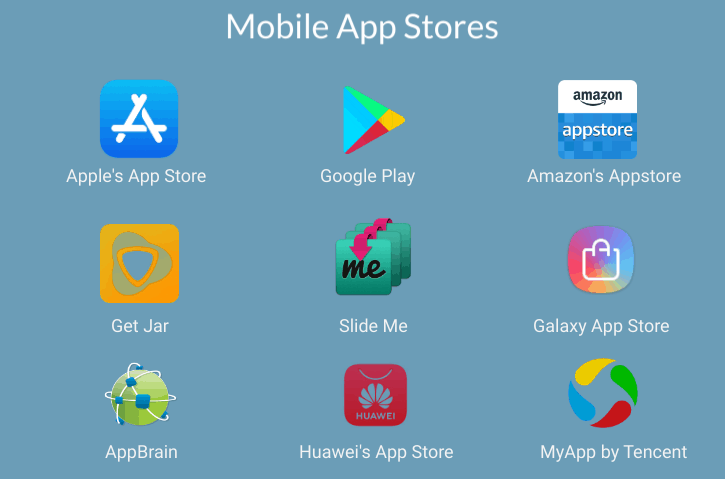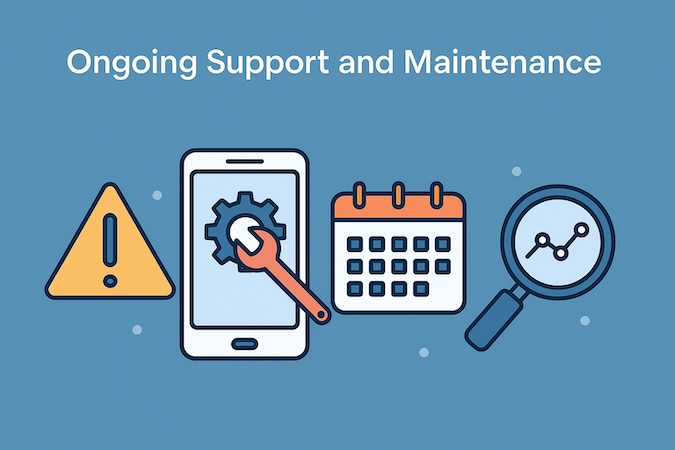We sincerely hope that you’ve set out to build a healthcare app because you’ve identified a genuine pain point that a medical app can solve. Not because another smarty-pants is heralding the billion-dollar mhealth industry.
Our experience (helping startups in health care and wellness raise over $188M) proves that a healthcare product is successful when its founders are truly passionate about improving people’s lives.
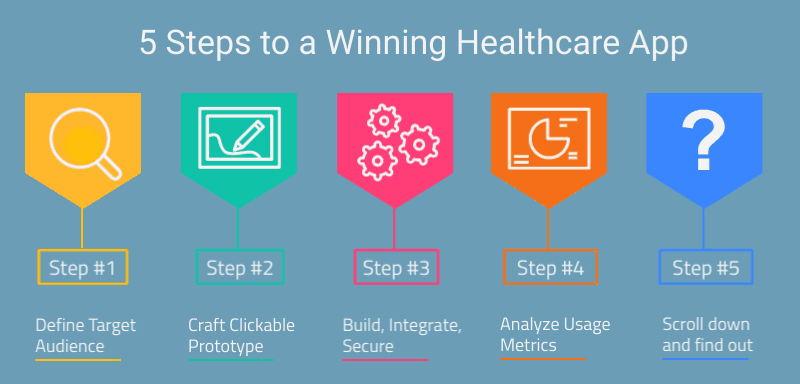
Let’s say you’ve figured out the passion and the industry’s pain points. Do you also know the steps you need to take to develop a healthcare app that will change people’s lives?
Well, if anything, skim through our healthcare app development guide and make sure you’re covering all the bases. We’ll answer the most frequent questions on how to create a medical app.
Table of Contents:
- Healthcare Applications Overview
- Types of Medical Apps
- Top 5 Successful Healthcare Apps
- Benefits of Healthcare Apps For Doctors And Patients
- Must-Have Features in a Health Application
- Next-Gen Features in Healthcare Application
- Monetization Models of a Healthcare Application
- The 5 Steps to Build a Medical App
- Best Practices for Healthcare Mobile Application Development
- How Much Does it Cost to Create a Healthcare App?
- Trends in Mobile Health App Development
- How to Choose a Healthcare App Development Company
- Topflight Experience in Developing Healthcare Applications
Healthcare Applications Overview
If you are planning to make a medical app, it’s worth knowing what’s happening in the market. 2020 definitely made history as the year of COVID-19. The coronavirus pandemic made quite a splash not only in our lives but also in the health apps market. Every aspect of healthcare that has to do with telemedicine, AI, and remote patient monitoring (RPM) got a huge boost (up nearly 300% in investment, according to CB Insights).
In 2021, digital healthcare innovations have continued to attract even more capital, with total funding almost doubling from the beginning of 2020 to $34,7 billion. Fastforward to 2022 and 2023 – digital health startups raised $15.3 billion in 2022, and $10.7 billion in 2023, marking the lowest amount of capital invested in the sector since 2019.
Sectors that have managed to reach new record-highs in healthcare funding include:
- Artificial Intelligence
- Telemedicine
- Mental health
- Digital therapeutics
- Omics
Healthcare executives continue focusing on improving the patient experience by investing in development of telemedicine, EHR interoperability, and patient portals.
The deal market has slowed down in 2022 and 2023, marking a 57% decrease from the peak in 2021. However, the outlook for 2024 and beyond is bright. In BCG’s latest investor survey, 65% reported an optimistic outlook over the next three years, with confidence potentially growing if macroeconomic conditions improve. Additionally, US private equity investors are holding a record $1 trillion in dry powder, indicating that the capital is ready to flow once market confidence returns. This positive sentiment bodes well for sectors like application development in healthcare, where innovation and investment could drive significant growth.
As doctors and patients are looking for new ways to connect while keeping their distance, telehealth apps will continue to dominate the space. I’m sure we’ll see more telemedicine and RPM solutions in the near future, but let’s take a look at what’s happening with healthcare apps in the stores right now.
According to Statista, there were 88,000 mobile health apps in Google Play and Apple’s App Store combined, and some random research into health-related applications claimed 325,000. Fast forward to 2024, and today there are approximately 54,000 health apps available on the Apple App Store and over 65,300 health apps available on the Google Play Store.
Image credit: Statista
Related: How to Develop a Telehealth App
In recent times, people can choose from over 100,000 mobile apps for their smartphones, and admittedly, that’s a lot of apps to compete against. At the same time, if you check the top 100 ranking health products in both stores, you won’t notice much versatility. You’ll be scrolling through lots and lots of fitness applications, calorie trackers, period trackers, and meditation products before you get to a decent telemedicine solution like Healow or Babylon.
What’s more, the sum of downloads for the top eight telemedicine apps doesn’t even scratch the surface of what the health & fitness categories generate. So focusing on the meditation and fitness areas will probably get you further if you’re targeting the general public.
Read Also Our Guide How to Build a Fitness App
And if you came up with an idea to cater to your patients, then there’s no need to look at the trending products. Just make sure you’re adequately fulfilling your customers’ unique needs.
Types of Medical Apps
If we look at different mobile medical solutions available today, we’ll see many options gravitating towards three audiences: patients, medical personnel, and the administration. It certainly helps to know these before developing a health app.
Health Apps for Patients
- Appointment scheduling and reminders
- Self-diagnosing
- Habit tracking
- Fitness and wellness
- Social networking
- Telehealth
- Mental health
- IoT medical products
- Women’s health
Related: How to Build a Patient Portal App
Health Apps for Providers
- Remote patient monitoring
- Telemedicine
- Diagnosis
- EHR
- Medicine reference
- Hospital mobile app ERPs
- Clinical communication
- Appointments management
Health Apps for Medical Administration Staff
- Doctor/nurse marketplace
- EMR/EHR
- Inventory management
- Billing
- Practice management applications
As you can see, whether you want to develop a health app for iOS or Android, there’s plenty to choose from.
Also, read our guide on How to Create an EMR/EHR System.
Top 5 Successful Healthcare Apps
It seems that any list out there ranking health apps is totally arbitrary. Would you make a list based on top free, paid, grossing, or trending, based on Google Play or Apple’s Store, or maybe consider software review platforms like G2 and Capterra?
Additional Read: Learn About White Labelling Telehealth Platform with Specode
Instead, we turned to CB Insights with their Healthcare Smart Money list that shows where top-performing VCs betting on healthcare put their money.
We then discovered this precious list of startups, busy with health application development, ranging by the investment size. And surprise-surprise, the best-funded apps come from those categories highlighted in the heat map by CB Insights. [Update as of June 2024: the top five right now looks like this: HingeHealth, Kry, Noom, K Health, Headspace – 3 top startups are still on this list].
Without further ado, here’s the list of mobile products that people who professionally invest in mobile health application development bet their money on:
#1. Kry
Video appointments with physicians and psychologists.
- over 800,000 patients treated
- 5-star rating from 97% of its patients
- doctors and psychologists speak 25 different languages
- open 24 hours, 7 days a week
KRY helps people take care of their physical and mental health. The application allows users to book a video appointment with one of their doctors or psychologists – at a time and place that’s convenient for the user. They offer drop-in appointments, or users can book one at a specific time.
Related: How to design and develop a doctor’s appointment app
#2. CareZone
Managing medications and doctor’s instructions.
- Always have a medication list with you
- Reminders help you stay on schedule
- Organize important info in one place
CareZone makes it simpler to take care of yourself, an aging parent, and other family members that need your help. The app allows users to take pictures of meds (prescriptions, OTC, and supplements) and the names, dosages, and other details are automatically added. There’s easy access to the list of medications, dosages, and schedules. Definitely a product to look up to if you want to learn how to make a medical app that scales.
#3. Headspace
A meditation solution with $168.2M vs. $116M for Calm — #1 medical app at the moment.
- Hundreds of guided meditations
- Workouts and mindful cardio
- SOS sessions for moments of stress
Headspace helps users get happy, stress less, and sleep well. It’s your guide to everyday mindfulness in just a few minutes a day. Users may choose from hundreds of guided meditations on everything from managing stress and anxiety to sleep, productivity, exercise, and physical health — including short SOS meditations for when they’re on the go.
Related: How to make a mental health app and How to create a meditation app like Headspace
#4. PatientsLikeMe
A social network for people who have the same disease or condition, plus a real-time research platform.
- Find a supportive social circle
- Connect one-on-one to find answers
- Use smart tracking tools to learn how you’re changing over time
With the PatientsLikeMe app, users can find support and answers from people like them and tools that will empower them to control their health. One can learn how others manage their symptoms and see what’s working. Plus, users post updates and interact with others on a news feed. A DailyMe feature helps them log how they’re feeling on a daily basis and get support from other users.
Discover how Specode, our super flexible and powerful AI development framework, accelerates custom healthcare software development, enabling healthcare apps to be built blitz-fast and tailored to your unique needs.
#5. Hinge Health
An IoT medical app that comes with a tablet and wearable sensors to give users live feedback during stretches and exercises.
- Complete personalized exercise therapy sessions
- Move at your own pace through levels
- Learn about the best ways of beating persistent pain
Read about our experience in wearable app development
Hinge Health is the pioneer in the area managing chronic musculoskeletal conditions,e.g., back or joint pain. The app and special clap-on sensors provide users with live feedback as they perform stretches and other exercises. The mobile app guides users through 15-minute sessions, and difficulty level gradually increases as the sensors data indicates the progress.
Check out our article about creating an IoT application
Benefits of Healthcare Apps For Doctors And Patients
Custom app development for healthcare offers countless advantages to patients and providers and facilitates the progress of healthcare industry as a whole. Let’s go over a few benefits we can get from professional healthcare apps.
Benefits For Doctors
Development of a health app is a time-consuming and often expensive undertaking. How can we prove its value to investors and stakeholders?
-
Faster decision making
As a result, doctors get to spend more quality time with patients, and help more patients overall.
-
More accurate diagnosing
This means better treatment plans, timely health care delivery, and improved outcomes.
-
Less stress and burnout
Software frees doctors from mundane tasks, increases efficiency of the health system. It’s astonishing how removal of paperwork can rise medical professionals’ morale.
-
Improved communication between professionals
Telemedicine healthcare application platforms help doctors connect with each other for consultations no matter where they are.
-
Better hospital and equipment management
IoT and other technologies allow health organizations to track their equipment in real time and optimize its use accordingly. For example, we can develop a mobile app for hospital to track the location of all on-premise ventilators. This is a great example of how hospital mobile app development can directly support operational efficiency and resource utilization.
-
Reduced cost of healthcare provision
All these benefits add up to reduce the cost of healthcare services.
Benefits For Patients
Now to the benefits that patients get to enjoy as a result of healthcare mobile application development.
-
Higher quality care
With all automations available to providers, patients can receive personal health plans, which respect their individual conditions.
-
On-demand accessible care
A healthcare mobile app platform makes some healthcare services available as if you wanted to rent on Airbnb or order sushi. That also means that care gets delivered faster, including meds delivery and remote consultations.
-
Better control over health data
Patients can export medical records and share them with other institutions. App development healthcare solutions ensure that this process is seamless and secure.
-
Secure payments
In-app payments with credit cards are definitely appreciated and can be easily implemented during medical application development.
-
Engagement
Finally, e-health solutions give patients more control over their therapy, making them active participants of the process.
One key step in healthcare app development is choosing the right custom mobile app development company to ensure a seamless experience for patients.
Must-Have Features in a Health Application
To build healthcare applications that people would actually want to use means to include features that engage users and offer them tangible benefits. Of course, the choice of features will depend on whether you want to build a mobile medical solution for glucose tracking, fitness, or, let’s say, for remote patient monitoring.
Still, there are a number of must-have features that every health application needs to be considered a success.
Integrations with Google Fit, HealthKit, and Samsung Health
Most healthcare apps have to deal with patient data. In that regard, services like Google Fit and HealthKit work as data hubs keeping user vitals. They also go a long way in simplifying user onboarding.
Patient and doctor profiles
All app data should be organized in user profiles that patients and doctors should be able to edit at any point. Doctor profiles must include enough info about a specialist so patients can make their choice easier.
Telemedicine options
Being able to connect with care providers in real time via video calls or messaging has become a necessity if you want to develop a medical app that works at a distance.
Related : HIPAA Compliant Video Conferencing and Messaging
Reminders and notifications
What mobile applications really excel at is keeping you up-to-date on your prescriptions and medicine intake. These notifications can be not only time- but also location-based.
Also Read: E-Prescription App Development Guide
HIPAA compliance
Of course, all PHI data must be kept secure, and the HIPAA rules that every health app must adhere to, make sure you follow suit. Therefore, it’s vital to encrypt data, provide two-factor authentication, use secure connections, and follow many other protocols to keep everybody’s data safe. When considering health mobile app development, ensuring HIPAA compliance is critical to protect sensitive patient information and maintain trust.
Related: The Complete Guide to Building a HIPAA Compliant Application
Next-Gen Features in Healthcare Applications
If we look closer at what technologies drive innovation in modern medical software development, we’d have to admit it’s the same technologies that attract the most funding. By adding the corresponding features to your medical app, you can significantly upgrade user experiences and guarantee higher adoption rates among patients and doctors. What exactly are we talking about?
AI and ML
Artificial intelligence is becoming absolutely instrumental in various medical spheres. Today’s healthcare software, equipped with machine learning algorithms, helps with early diagnosing, identifying health trends, and analyzing massive sets of health data. As a result, doctors can make decisions and adjust patient treatment faster, catering to their unique needs.
What are the most common applications of AI in healthcare apps?
- generative AI
- intelligent chatbots learning about the patient’s condition during a conversation
- medical imagery analysis and patterns identification
- symptom tracking and analyzing apps
- real-time posture detection
- ML algorithms fostering discovery and development of new drugs
- preventive medicine
- patient flow optimization
Related: How to Develop a Machine Learning App: The Ultimate Guide
Blockchain
Also Read: Blockchain in the Medical Field
Blockchain is another novel technology set to disrupt the medical field. One of the major advantages that blockchain brings to the table is solving the interoperability issue. For example, solutions like Medblock allow healthcare organizations to share patient data securely on a permissioned ledger, which ensures all patient records remain tamper-proof.
- integration with multiple EHR systems
- medicine tracking in supply chains
- decentralized patient portals where each patient owns and controls access to her data
When considering mobile healthcare application development, blockchain’s ability to provide secure, interoperable solutions cannot be overlooked.
IoT
The internet of medical things has been a trend for quite some time. However, with the latest technology advancements, more use cases emerge for applying this cutting-edge solution. Modern IoT systems in healthcare go well beyond tracking patients’ vitals. Besides remote patient monitoring, IoT also helps with medical inventory management, assistance during surgeries, and pharmacy management.
- smart medical appliances
- wearables supporting advanced sensors like ECG and EDA
- traceable medicine
Related: How to Develop a Medical IoT App and How to Develop a Remote Patient Monitoring App
Big Data
Of course, you can’t design a scalable healthcare app without addressing the big data issue. Since AI and IoT assume the generation of vast amounts of data, there needs to be a mechanism to process all this information. Therefore, architecting datasets that handle literally millions of calculations in real time goes hand in hand with implementing ML and IoT functionality in healthcare.
AR and VR
Despite augmented reality and virtual reality often being shrugged off as tech suitable just for games like Pokemon, there are quite a few practical applications for both in medicine. The first thing that comes to mind is therapy sessions with a simulated environment, especially when carried out remotely. AR also helps surgeons to train safely and teach students required skills, or we can use it for indoor navigation in clinics.
Related: AR App Development Guide
Monetization Models of a Healthcare Application
How you make money off your custom healthcare solution depends on the product itself. Is it going to be a hospital app for patients, medical mobile software for providers, or an IoT companion app tied to a smart device? Here are some of the monetization options available for these variants.
Also Read: A Complete Guide to App Monetization
Subscription
Nothing gets your accounting happier than scheduled payments coming in from subscribers. Works best not only for mobile apps intended for regular use but also for web solutions. In the b2b world, they call it a SaaS monetization, and it works essentially the same.
Service sales
Onetime purchases of various services that your organization provides.
Ads are a big no
Don’t even think about integrating ads and soliciting a sale to turn them off. You’ll end up annoying customers or spending too much time monitoring the quality and relevance of ads.
Sponsorship
Helpful when your app implies using specific brands of medical equipment or other products.
Licensing
This monetization model is similar to the b2b SaaS model, but when you sell a license for using your software, you get royalties.
Pay per download
The oldest model in the mobile industry and the least popular these days because you’d either have to maintain a free version with limited functionality or customers won’t be able to try out your software.
Device sales
If you sell smart medical sensors that work with an IoT mobile app, the hardware package usually includes the software price.
Patient data
Finally, pharma companies and other medical research businesses will pay for anonymized patient data and other medical information your solution accumulates.
If you look at the revenue streams, they may come from:
- patients
- providers
- employers (corporate wellness programs)
- medical research institutions
- insurance companies (or government, if you’re that lucky)
The 5 Steps to Build a Medical App: Complete Process
Developing a medical app involves a structured process, ensuring functionality, compliance, and user satisfaction. If you’re wondering how to build a healthcare app, this guide outlines the five essential steps. Each step includes detailed substeps to help you streamline the development process and ensure a successful outcome.
Summary table of the 5 steps to create a medical app:
| Step | Activities and Substeps |
|---|---|
| 1. Define Your Audience | – Identify target users and understand their needs: – Assess user context (e.g., standing vs. sitting). – Choose between professional users (e.g., nurses) or patients. – Determine the primary customer base. |
| 2. Build a Clickable Prototype | – Create a low-cost, interactive design: – Use tools like Figma or Proto.io. – Conduct A/B testing with users. – Validate the feasibility of features with developers. |
| 3. Focus on Compliance and Privacy | – Ensure data security and regulatory alignment: – Implement HIPAA-compliant data handling. – Integrate APIs securely (e.g., HealthKit). – Follow relevant standards like ISO 27001 or IEC 62304. |
| 4. Develop and Test | – Implement, test, and iterate: – Use Agile sprints for efficient development. – Conduct unit and system tests. – Integrate with legacy systems and EHR platforms. |
| 5. Launch and Build an Ecosystem | – Deploy and expand functionality: – Release to app stores or distribute privately. – Monitor analytics for feedback. – Explore additional platforms like smartwatches or browser-based dashboards. |
Step #1: Planning and Strategy
If you are reading this, chances are you already know your target audience. We’ve discovered that successful medical apps are always built by someone serving in the field: either with a medical or nursing degree or working closely with healthcare providers. You really need industry-specific insights when developing a medical software program.
Also Read: Virtual Nurse App Development Guide
Define your medical app’s audience
Get to know the potential users of your app. Their needs and pet peeves will drive every significant decision you’re about to make when building the healthcare app. Remember, it’s all about their context for using your solution:
- Will users be standing or sitting?
- Will they have both hands free?
- Will they have time to interact, or will a glance suffice?
- Will they face patients when using the app?
Related: The Ultimate Guide to Building The Best mHealth Apps
Define the app’s purpose and goals
Even the most polished healthcare app will flop if it doesn’t solve a real problem—or worse, if it tries to solve five at once.
Start with a single, well-defined clinical or operational pain point. That could be reducing no-shows, speeding up intake, improving chronic care adherence, or helping nurses chart faster during rounds. Focus sharpens scope, which sharpens success.
Here’s a trick we use with founders:
Write down your app’s ideal outcome in one sentence, then finish this: “We’ll know the app is working when…”
Some examples:
-
“…patients complete onboarding in under 2 minutes.”
-
“…physicians spend 30% less time on documentation.”
-
“…our pilot site reduces hospital readmissions by 10%.”
Those benchmarks shape everything—UX, feature set, even how you pitch investors or frame your FDA pathway, if relevant.
Conduct market research
This is where app ideas go to either sharpen—or quietly die. And that’s a good thing.
Before you sink resources into design and development, take a hard look at what’s already out there. Odds are, there’s someone solving a similar problem. Your job? Find the gaps they’re missing—or the friction they haven’t addressed.
Start here:
-
App Store sweep: Look at top healthcare apps in your category (telehealth, chronic care, etc.). What are users complaining about in the reviews? That’s gold.
-
Competitive teardown: Identify 3–5 similar apps. Analyze their features, UX, monetization, and user base. Ask: what’s their wedge? what’s missing?
-
Regulatory context: What rules (HIPAA, GDPR, FDA) shape your competitors’ limitations—and how might you turn those into an edge?
-
Clinical validation: If your app touches diagnoses or care pathways, look for supporting studies or trials your competitors reference—or skip. This can help you shape a more credible MVP.
And if there’s nothing like your idea? Don’t celebrate just yet. Dig deeper. It might be a signal the market’s not ready—or that previous attempts flopped for a reason.
Choose a suitable platform and technology stack
These and myriad of other questions will influence the features you’ll build into the health app direct your choice of mobile devices and platforms:
- iOS or Android (Apple and Android healthcare application development have nuances)
- smartphones / tablets / smartwatches / smart speakers
- AI integration by Google / IBM / Microsoft
- AR, VR, or telemedicine IoT integration
Let’s look at some of the most popular types of healthcare apps out there. The diagram is far from covering the whole spectrum of apps that you can build, of course. Instead, it’ll help you jump-start on your app idea quest and, eventually, will allow you to hone in on your target audience:
And by the way, thinking outside the box is always welcome. Is there a place for a healthcare app game? You bet. There’re plenty on Google Play already! Is there a place for a solution that connects to a smart pillbox and tracks medicine intake? Yes, we developed a similar product.
And once you’ve picked your platforms, don’t forget the invisible backbone: your technology stack.
The choices you make here will determine how fast you can ship, how easy it’ll be to scale, and how expensive it’ll be to maintain. That includes:
- Frontend frameworks like React Native or Flutter (great for cross-platform apps)
- Backend stacks like Node.js, Python/Django, or serverless options for rapid iteration
- Cloud infrastructure—AWS, Azure, GCP—all offer HIPAA-compliant services, but the devil’s in the details
- Database choices—relational (PostgreSQL), NoSQL (MongoDB), or even FHIR-ready data models
- Third-party integrations—from Twilio (for SMS/voice) to Redox or Health Gorilla (for EHR interoperability)
- Our rule of thumb? Avoid overengineering on Day 1. Pick tools your team knows—or that come with strong healthcare community support. Yes, you can always refactor later. But getting the stack right early helps avoid expensive pivots once patient data’s already flowing.
Create a phased implementation strategy
Spoiler alert: you don’t need to build the whole app at once. In fact, you shouldn’t.
A phased approach lets you test assumptions, reduce risk, and stay aligned with real-world needs—especially in healthcare, where requirements shift fast and clinical workflows are never as straightforward as they look in diagrams.
Here’s how to think about your rollout:
-
Phase 1: Core MVP
Focus on your app’s “one job”—the single most valuable action it enables. Strip away everything else.
Example: Let users request virtual visits—skip full EHR integration for now.
-
Phase 2: Feedback & Iteration
Ship to a small cohort (e.g. a single clinic or department), gather usage data, and observe real behavior. What do users skip? Where do they get stuck?
-
Phase 3: Scale + Integrate
Only now start layering on advanced features like wearables, AI, or EHR sync. Prioritize what delivers measurable impact—not what looks good in a demo.
This roadmap doesn’t just help your team stay focused. It also makes you more attractive to investors and clinical partners, who love a de-risked, data-backed approach to scaling.
Step #2: Here’s how you build a healthcare app without building it
Yes, that’s right. You don’t have to throw yourself into mobile healthcare app development services right after putting together a list of features and requirements. Every line of code is money out of your pocket. Why don’t you spend it on finalizing the concept of your iPhone healthcare app instead of starting medical iPhone app development right away?
You do this by prototyping: fleshing out medical features into clickable screens that look almost identical to a real-life product. The beauty of a clickable prototype is:
- you can experience it on your phone as if working with an actual app
- you can quickly get a prototype in the hands of users for A/B testing
- you can verify with a developer if all features are quite feasible on a selected platform
And all of that without draining your development budget. Despite being ultra-important when building a healthcare app, UX & UI work often accounts for a fraction of the total cost, unlike coding.
It‘s 10x cheaper to fix a design flaw while
prototyping than during development.
Joe Tuan, founder, Topflight Apps
Read more about Health App Design
Today, there’s no shortage of interactive tools for rapid prototyping. Some, like Balsamiq or Proto.io, are so easy-to-use that it will be hard to resist the urge to try your hand at putting together a couple of mocks. Others, like Adobe XD or InVision, require design resources with more hands-on expertise in healthcare mobile app development.
Related: Using Figma for Prototyping: The Complete Breakdown
The bottom line is when prototyping, you’re kind of building your healthcare app, and, at the same time, you’re not. Only because at this stage, your users can’t download the product or perform any non-hard-wired action in the prototype.
Step #3: Design and Development
At this point, you already have all the features that your medical app will ship with. And the click-through prototype. You’re fully equipped, and nothing can stop you from plunging headfirst into the development of your healthcare app, right?
Right — in many cases, but not so fast if you’re looking to build an exceptional healthcare experience. We suggest you concentrate on the following points during the development process to ensure you’re building a health app that will make a real impact.
Create user personas and wireframes
Before a single line of code gets written, you need to model reality—your users’ reality. That’s where personas come in.
Each user persona should reflect a specific context: a busy primary care doc, a diabetic patient juggling meds, a scheduler at a small clinic. Their workflows, frustrations, and device preferences must shape what your app becomes.
Once you know who you’re building for, wireframes help explore how they’ll use it. Think of wireframes as the architectural blueprint—quick to build, easier to rip apart, and essential for vetting assumptions before moving pixels or code.
We typically test low-fidelity wireframes with 3–5 stakeholders to validate the core flow. If they stumble? Better now than post-launch.
Design a user-friendly interface
A sleek interface might win awards—but a usable interface wins adoption. Healthcare apps should feel effortless, not impressive.
Key UI/UX rules we follow religiously:
-
Minimize cognitive load: fewer steps, fewer decisions per screen
-
Respect clinical workflows: if a nurse needs two thumbs to chart, it’s a fail
-
Use visual hierarchy smartly: critical data goes top-left or top-center
-
Design for interruption: auto-save everything, allow quick resume
Don’t chase novelty here. A good healthcare UI often looks… boring. And that’s by design—because consistency breeds trust.
Develop and test the app
Once the designs are validated, it’s go time. But development shouldn’t be a sprint to the finish line—it’s more like a relay with frequent checkpoints.
We recommend breaking builds into clearly defined feature modules. Each one should ship with:
-
Unit tests baked in
-
Automated regression testing where possible
-
A clear QA checklist that includes edge cases, device constraints, and connectivity drop-offs (this is healthcare—we expect spotty Wi-Fi)
And don’t forget to test your error states. A blank screen when an API fails could mean a missed appointment or a misdiagnosis.
Implement robust security measures
Security isn’t just about compliance—it’s about protecting lives.
Besides encrypting data in transit and at rest, you should:
-
Enforce strict role-based access control (RBAC)
-
Use token-based authentication (e.g., OAuth 2.0, OpenID Connect)
-
Set automatic session timeouts for idle users
-
Run penetration tests before go-live
-
Monitor logs for anomalous access patterns—and be ready to revoke credentials in real time
Also: never store credentials or patient data directly on the device unless absolutely necessary—and even then, encrypt it locally and limit access.
APIs & Integrations with existing systems
To lure in modern power users and newbies, your app will likely integrate with other services. That’s how you leverage the location and proximity data, make use of vitals offered via HealthKit, work with EHR systems, and do a lot of other wonders during mobile medical app development.
Make sure if the corresponding APIs are available for commercial use and whether you are required to open source your code after using them.
Compliance, Privacy and Security
No, it’s not about the proverbial HIPAA compliance that should be in place whenever patients’ protected health information (PHI) is at play. Depending on the type and functionality of your medical app, you will need to wrap your head around such concepts as:
Apple’s Human Interface Guidelines for CareKit and HealthKit
- Android.os.health documentation
- IEC 62304, ISO27001, SOC2 Type 2, and a few other standards
- MFi Program
- HITECH Act, GDPR, and other data security regulations
Patient data should always be traveling to and from the app in an encrypted format over a secure connection. Handling PHI according to HIPAA guidelines during a healthcare mobile development project is paramount.
Related: HIPAA Compliant App Development: Everything You Need to Know
Agile & Continuous Delivery
Agile is probably already one of your mantras. Well, it’s the perfect time to start practicing. During medical mobile app development, it’s essential to realize that proceeding by brief, one-week sprints, you’re likely to arrive at the desired destination faster and with fewer iterations. There will be time to test the completed scope and adjust future sprints if necessary.
Related: Agile App Development: The Business Owner’s Guide
Another aspect you should be paying attention to is continuous delivery. The team developing your healthcare app must set up an environment that allows QA engineers and you to test completed features without interfering with the development of the next round of features.
If you opt for healthcare Android app development, you are likely to reach more users. However, if you choose to make the software using React Native or other cross-platform framework, you will release simultaneously to iOS and Android, covering even a bigger audience.
Make the Best Use of Legacy Solutions
Incumbents in the healthcare industry often have to deal with legacy software that they’ve accumulated over years. These can be EHR platforms, old databases, content management systems, CRMs, and other (often outdated) healthcare solutions.
The typical approach when building a novel healthcare application is to pull data from these legacy systems into a new application and ditch the original infrastructure. But what if providers and management staff still work with the existing software?
Not all businesses have budgets to replace their legacy systems at once. The old stuff needs to operate flawlessly as its components are being gradually replaced. If this sounds familiar, an optimal route would be to develop a data hub that would act as a syncing link between the new healthcare app and legacy systems.
With such a hub, legacy software can share all data with the new application without introducing unnecessary hurdles for providers working with old software. A special set of APIs will push any new data from the original solutions to a newly built application, and vice versa. Just remember that such a data hub should be HIPAA compliant.
Step #4: Launch and Maintenance
What do you do with an app that’s been built? That’s right — release it to the App Store, Google Play, or distribute it to users on an ad hoc basis if it’s a staff-only medical app. That’s also when the real fun starts. Because as soon as you launch the product, you start thinking about possible future iterations.
Launch the app
Launch day isn’t a finish line—it’s opening night. And just like any good premiere, you want to make sure the audience shows up, everything runs on time, and nobody forgets their lines.
Whether you’re submitting to the App Store, Google Play, or pushing via an MDM platform for internal staff, don’t underestimate the pre-launch checklist:
-
Double-check app metadata (privacy policy, screenshots, keywords)
-
Run final QA on production builds
-
Test push notifications and deep links
-
Confirm data connections (especially if syncing with EHRs or wearables)
Pro tip: soft-launch to a small audience first. It gives you a buffer to catch issues early—without tanking your App Store ratings on Day 1.
Provide ongoing support and maintenance
No healthcare app survives contact with the real world without a little bruising. Once it’s live, expect a steady stream of bug reports, OS edge cases, and enhancement requests.
The winning approach? Treat maintenance as a continuous service, not a one-off fire drill:
-
Set up a triage system for incoming issues
-
Schedule regular sprint reviews focused solely on post-launch improvements
-
Monitor error logs and crash reports (e.g., via Sentry, Firebase Crashlytics)
-
Document every fix or patch—especially if you’re heading toward FDA clearance
Also: keep your dependencies and libraries updated. Falling behind not only invites security risks—it compounds your technical debt like interest on a bad loan.
Sneak up on users, legit
If you’re siding with a pro development team to build your healthcare app, your mobile product already integrates with some analytics product that gathers usage metrics. All you need is to read and interpret this data to find the potential for enhancements:
- you might want users to stick with the product longer
- you want to enable users to achieve their goals faster
- you might want to increase their spend
Whatever it is you’re trying to achieve — the app usage data coming, e.g., from Firebase or Appsee is a reliable source of insight for future upgrades during the next Android healthcare app development iterations.
Gather user feedback
You can always integrate a customer feedback system if you want to allow users to vent their frustration with the app without leaving a negative review. To enable this functionality, take a closer look at the solutions like UserVoice or UserTesting. And it certainly never hurts to monitor and interact with user reviews you get in app stores.
Watch major OS updates
New features may also come as you update your healthcare app to support the latest OS version. It’s worth noting that even though most OS updates leave existing apps intact, updating your mobile product is always a better idea. This way, you don’t accumulate any technical debt and make use of the latest OS features.
Believe me, you don’t want to know what technical debt is (reach out directly if you do!). You just don’t want to accumulate this debt and spend a hefty budget on dealing with it later on.
Spy on competition
Today’s App Store monitoring platforms like Sensor Tower or data.ai allow you to stay up to date on your niche competitors, checking their App Store and Google Play rankings. This practice also involves applying a solid App Store Optimization strategy, and it’s way more than picking the right keywords. We have a separate Guide on App Store Optimization for Mobile Apps in 2023 if you’d like to dig deeper.
Step #5: Build an ecosystem around your healthcare app
Now that your app is on track with receiving timely updates and new features (dull people call this a maintenance mode), it’s time to step back and take a look at the bigger picture. Do you see the potential for driving more value for your medical app users by extending to more platforms? Or is there a particular platform (smartwatch anyone?) that just calls for integration?
What if users could see more detailed reports in the cloud-based version of the app — the one they could access via a desktop browser? Does it make sense to come up with a smartwatch version?
At some point, you’re bound to start noticing these opportunities. So go ahead and turn them into growth points by building your healthcare app into an entire ecosystem.
Best Practices for Healthcare Mobile Application Development
Creating an effective and user-friendly mobile application the healthcare niche is paramount. As medical mobile application development becomes increasingly sophisticated, developers must adhere to best practices to ensure their apps meet the highest standards of functionality, security, and user experience. Here are some key practices to consider:
User-Centric Design
Begin with a comprehensive understanding of your target audience’s needs. Prioritize user-centric design principles to create an intuitive interface that enhances user engagement and satisfaction. This involves conducting thorough user research, usability testing, and iterative design improvements.
Compliance with Regulations
Ensure your app complies with all relevant healthcare regulations and standards, such as HIPAA in the United States or GDPR in Europe. This guarantees the protection of sensitive patient information and builds trust with users. At the same time, you can try and deter storing PHI data in your application to delay HIPAA compliance and lower costs at the start of the project. It’s a safe and easy way to avoid problems with setting up compliant development environment, too, which can be challenging when you’re only starting a project.
Robust Data Security
Implement strong encryption protocols and secure data storage solutions to protect patient data from breaches and unauthorized access. Regularly update security measures to address emerging threats.
Seamless Integration
Facilitate seamless integration of your app with existing healthcare systems like Electronic Health Records (EHR) and other third-party services. This enhances the app’s functionality and provides a more comprehensive tool for healthcare providers and patients.
Scalability
Design your app with scalability in mind. As your user base grows and new features are added, ensure the app can handle increased demand without compromising performance or user experience.
Interoperability
Promote interoperability by ensuring your app communicates effectively with other healthcare apps and systems. This smooth exchange of information can significantly improve the efficiency of healthcare delivery.
Continuous Testing and Feedback
Engage in continuous testing and solicit feedback from users regularly. This helps identify potential issues early and allows for timely improvements, ensuring the app remains reliable and effective.
Focus on Core Features
Prioritize core features that address the primary needs of your users. Avoid overloading the app with unnecessary functionalities, which can complicate the user experience and detract from the main purpose of the app.
Regular Updates and Maintenance
Keep your app up to date with regular updates and maintenance. This includes fixing bugs, improving performance, and adding new features based on user feedback and technological advancements.
Effective Communication Channels
Incorporate effective communication channels within the app, such as chat features or telehealth capabilities. This can greatly enhance patient-provider interactions and streamline the care process.
By adhering to these best practices in medical mobile application development, you can build a robust, secure, and user-friendly app that meets the needs of both healthcare providers and patients, ultimately transforming patient care and operational efficiency.
How Much Does it Cost to Create a Healthcare App?
The cost of mobile app development for healthcare can vary significantly, from an IoT-enabled $55,000 MVP (minimum viable product) for a heart rate tracker to a $260,000 telemedicine solution to a $380,000+ full-cycle practice management platform. Of course, the budget for building a healthcare app will always depend on the type of product you want to create.
One question we hear a lot is How to develop a healthcare app and not lose investors’ money?
The framework we often revert to, to help our clients optimize the ROI is rapid prototyping. The sheer fact of having a near-real-life experience with zero code always excites us. We build clickable, interactive prototypes, and then relentlessly test them with the target audience to make sure user journeys make sense.
And after we’ve verified that the solution offers an optimal user experience, we start coding it in the flesh. This approach considerably saves the budget required to create a health app.
If you’re asking how much it will cost to get a healthcare application off the ground using Topflight’s experience, the short answer is at least $60,000. That’s the min cost to engage us in developing a PoC or MVP. I also encourage you to check out our Vision to Traction System that has helped our partners raise millions of dollars using our development services.
Trends in Mobile Health App Development
As the landscape of healthcare applications development continues to evolve, staying ahead of the trends is crucial for app founders, entrepreneurs, and clinical executives looking to build innovative solutions. Here are some of the most significant trends shaping the future of mobile health app development in 2024:
Artificial Intelligence and Machine Learning
AI and ML are revolutionizing healthcare by providing predictive analytics, personalized medicine, and automated workflows. These technologies can enhance diagnostic accuracy, streamline administrative tasks, and improve patient outcomes. Incorporating AI and ML into your healthcare app can provide a competitive edge by offering advanced capabilities that can analyze vast amounts of data in real-time.
- Predictive Maintenance: AI can anticipate potential equipment failures and maintenance needs, reducing downtime and improving efficiency.
- Virtual Health Assistants: AI-powered chatbots and virtual assistants can provide 24/7 support, answering patient queries and offering basic medical advice.
- Clinical Decision Support: Machine learning algorithms can assist clinicians by providing evidence-based recommendations and highlighting critical patient information.
For a deeper dive into implementation expenses and ROI, check out our detailed breakdown on the cost of AI in healthcare.
Telehealth Integration
The demand for telehealth services has skyrocketed, and it’s now a staple feature in healthcare applications development. Integrating telehealth allows for remote consultations, continuous patient monitoring, and improved access to care, especially for patients in remote or underserved areas. This trend is expected to continue growing in digital health app development, making telehealth a must-have feature in any new healthcare app.
Blockchain for Enhanced Security
Blockchain technology is gaining traction in healthcare for its robust security features. It offers a decentralized way to store and manage patient data, ensuring that information is tamper-proof and secure. Implementing blockchain can enhance data security, improve transparency, and foster trust among users.
- Smart Contracts: Automate processes and enforce contractual agreements without the need for intermediaries.
- Immutable Records: Ensures that patient records are permanent and cannot be altered, providing a reliable audit trail.
- Decentralized Identity Management: Allows patients to control their personal health information and share it selectively with providers.
Wearable Technology Integration
Wearable devices such as smartwatches, fitness trackers, and medical sensors are increasingly being integrated into healthcare apps. These devices collect real-time health data, which can be used for monitoring patient health, conducting remote diagnostics, and encouraging healthier lifestyles. Integrating wearables in your app can provide valuable insights and a more holistic view of patient health.
Read more on medical device app development
Augmented Reality (AR) and Virtual Reality (VR)
AR and VR are being utilized for various healthcare applications, including surgery simulations, patient education, and rehabilitation therapy. These technologies offer immersive experiences that can enhance training, improve patient engagement, and provide innovative treatment options.
- Surgical Planning: Surgeons can use AR to visualize complex procedures and plan surgeries with higher precision.
- Patient Distraction: VR can be used to distract patients during painful procedures or treatments, reducing perceived pain and anxiety.
Remote Collaboration: AR-enabled devices can facilitate remote collaboration among healthcare professionals, allowing experts to assist in real-time from different locations.
Personalized Medicine
Personalized medicine, driven by genetic data and individual health profiles, is becoming a significant focus in healthcare apps development. Apps that can tailor treatments and health advice based on individual genetic information are likely to see increased adoption, as they can provide more effective and targeted care.
Interoperability Standards
Ensuring that healthcare apps can seamlessly communicate with other systems and applications is critical. The trend towards adopting interoperability standards, such as FHIR (Fast Healthcare Interoperability Resources), is essential for enabling the free flow of information across different platforms, improving care coordination, and reducing errors.
- Data Exchange: Facilitates the exchange of data between different EHR systems, enhancing the continuity of care.
- Standardized APIs: Using standardized APIs ensures that different systems can communicate effectively without custom integration.
- Improved Patient Outcomes: By sharing data effectively, healthcare providers can make more informed decisions, leading to better patient outcomes.
Voice-Activated Interfaces
Voice-activated interfaces are becoming more prevalent in healthcare apps, providing a hands-free way for users to interact with the application. This is particularly useful for clinicians who need to access information quickly without using their hands, and for patients who may find voice commands more accessible than touchscreens. Accessibility is a must in healthcare digital solutions these days.
Focus on Mental Health
With increasing awareness of mental health issues, there is a growing trend towards developing apps focused on mental wellness. These apps offer features such as mood tracking, guided meditation, and virtual therapy sessions. Addressing mental health can differentiate your app and provide much-needed support to users.
- Anonymity: Apps that allow users to seek help anonymously can reduce stigma and encourage more people to seek support.
- AI-driven Insights: Use AI to analyze user inputs and provide personalized mental health advice and resources.
- Community Features: Include forums or chat groups where users can connect with others facing similar challenges, fostering a sense of community and support.
By incorporating these trends into your strategy of app development for the healthcare industry, you can create innovative, secure, and user-friendly apps that meet the needs of both healthcare providers and patients, ensuring your app stands out in a competitive market.
How to Choose a Healthcare App Development Company
Selecting the right partner for professional healthcare app development is a critical decision that can significantly impact the success of your project. As founders and clinical executives, you need a development company that not only understands technology but also has deep insights into the healthcare industry. Here’s a guide to help you choose the right healthcare app development company:
Industry Experience and Expertise
Look for a company with substantial experience in the healthcare sector. They should have a proven track record of developing successful healthcare apps and a strong portfolio showcasing their work.
- Ensure the company understands the unique challenges and regulations of the healthcare industry, such as HIPAA compliance.
- Review detailed case studies to see how they have solved specific problems for other healthcare clients.
- Seek out feedback from previous clients to gauge their satisfaction with the company’s services and support.
Technical Proficiency
The technical skills of the development team are paramount. Verify that the company is proficient in the latest technologies and platforms relevant to health care app development.
- Check their expertise in essential technologies like AI, ML, blockchain, and interoperability standards (e.g., FHIR).
- Assess their ability to incorporate next-gen features and innovative solutions into your app.
- Ensure they can develop apps for both iOS and Android, providing a seamless experience across all devices.
Regulatory Compliance
Compliance with healthcare regulations is non-negotiable. The development company must be well-versed in relevant laws and standards to ensure your app meets all necessary requirements.
- Their development practices should prioritize data security and patient privacy.
- Confirm that they can provide thorough documentation to demonstrate compliance with healthcare regulations.
- The company should stay updated with regulatory changes and adapt the app accordingly.
Customization and Flexibility
Your healthcare app will have unique requirements. The development company should offer customized solutions tailored to your specific needs. They should build scalable solutions that can grow with your user base and evolving requirements.
- Ensure they can develop custom features that set your app apart from competitors.
- An agile approach allows for flexibility and iterative improvements based on feedback during the development process.
Communication and Project Management
Effective communication and robust project management are crucial for a smooth development process.
- The company should maintain clear and consistent communication throughout the project.
- A dedicated project manager or team ensures accountability and focus on your project.
- Regular updates and milestone tracking help you stay informed about the project’s progress.
Post-Launch Support and Maintenance
Ongoing support is vital to address any issues and keep your app up-to-date after launch. The company should be prepared to add new features and enhancements as your app evolves.
- Ensure they offer comprehensive maintenance plans for regular updates and bug fixes.
- Round-the-clock support can be crucial for addressing urgent issues promptly.
Cost and Value
While cost is an important factor, it shouldn’t be the sole criterion. Focus on the value that the development company brings to your project.
- Transparent Pricing: Look for a company that offers transparent pricing without hidden costs.
- ROI: Consider the return on investment (ROI) based on the quality of the app and its potential to meet your business goals.
- Discuss payment terms and schedules to ensure they align with your budget and financial planning.
By carefully evaluating these factors, you can select a mobile medical application development company that aligns with your vision, meets your technical and regulatory requirements, and provides ongoing support to ensure your app’s success.
Topflight Experience in Developing Healthcare Applications
At Topflight, we’re lucky to have worked on many versatile web and mobile healthcare applications. The entire company was built on the idea to help providers and medical organizations develop top-flight apps that customers would embrace.
Today, we can boast apps from the following healthcare specialties in our portfolio:
- Remote patient monitoring
- Telehealth
- Mental health
- Super-lightweight EHRs for clinics
- Uber for lab testing
- Fitness & wellbeing
- IoT solutions
- Enterprise-grade health applications
- AI-powered healthcare solutions
- AI/AR RPM for physiotherapy
- Uber for medical outstaffing
Having developed numerous mobile and cloud healthcare apps, we know that success comes with engaging user experience and laser-sharp focusing on the customer. That’s why we always start custom developing mobile apps with rapid prototyping.
Also Read: Guide to Cloud Computing in the Medical Field
More steps?
Even though we’ve touched upon many things concerning medical apps development, there’s always something extra that we share only with our clients and partners.
So if you’re looking to start a medical app, join the party by subscribing to our newsletter or schedule a call to ask more questions about building a healthcare app. It’s free and enlightening!
[This blog was originally published on March 2, 2020 but has been refreshed to keep up with more recent updates]
Related Articles:
- Physiotherapy app development guide
- Pediatrician App Development
- Mental Health Chatbots
- Guide to Creating a Pharmacy App
- Deep Learning Use Cases in Healthcare
- How to make a women health tracking app
- How to make a hospital management software
- Medication Tracker & Pill Reminder App Development Guide
- How to Collect Healthcare Data for Your Mobile Apps
- Guide to Computer Vision in Medicine
- Chatbots in Healthcare
Frequently Asked Questions
Do all healthcare apps need to be HIPAA compliant?
No, only mhealth software dealing with PHI needs to comply.
What would you suggest if you could give a single piece of advice to help me create an outstanding healthcare app?
Start with an interactive prototype and make sure you spend enough time testing it with real users from your target audience. This approach will save you a lot of time and effort. In fact, no software project should start with app development, healthcare too.
How can we apply blockchain technology to our medical software?
Right now, the best application of blockchain and smart contracts is when developing EHR platforms.
How do I make sure my application for patients remains competitive?
Use analytics tools like Mixpanel to understand how people use the app and whether they have any issues. You could also rely on proactive solutions for gathering user feedback before they publish it in the App Store.
How long does it take to build a medical app?
I’m sure you’re fully aware, there’s no such thing as an average medical application. Each app is unique. We built healthcare software that required 6 months of development; other solutions took over a year to get ready for the market.
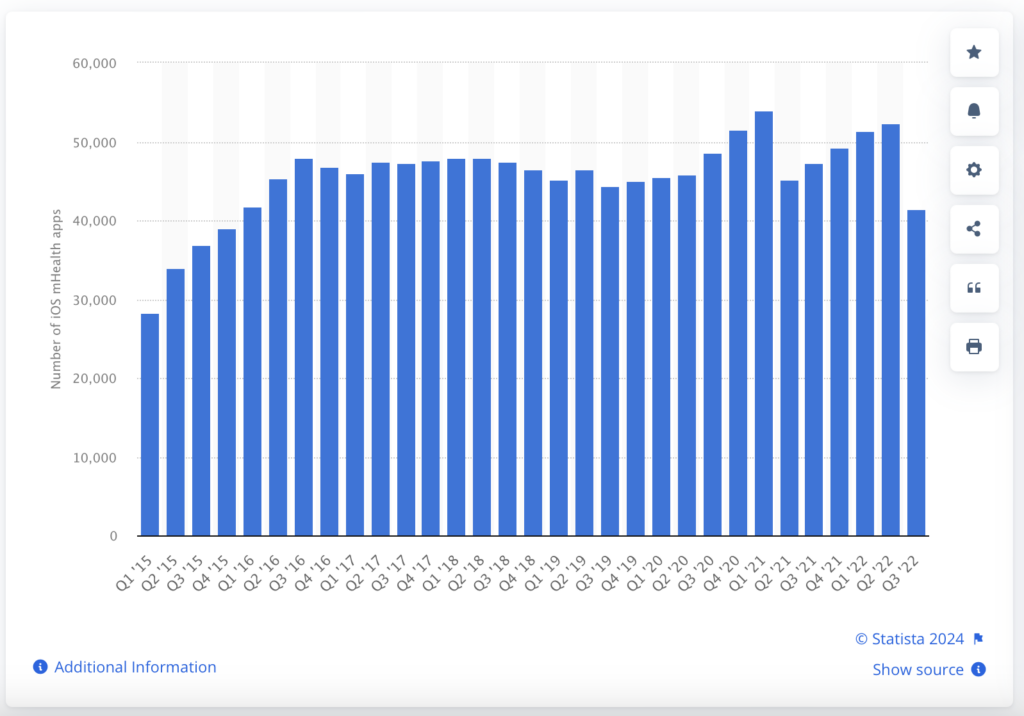

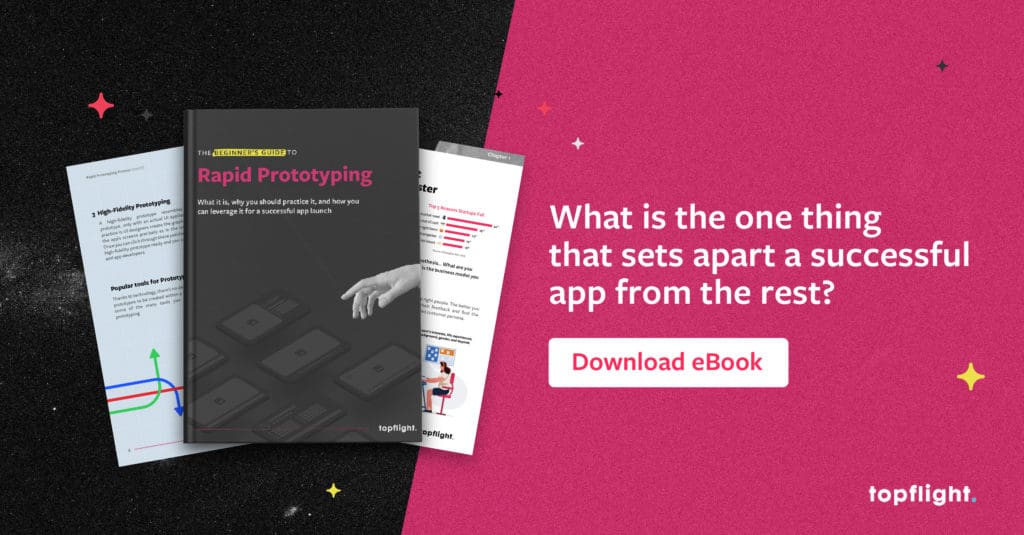
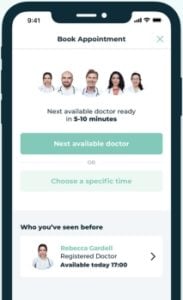
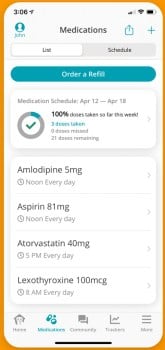
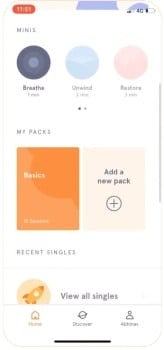
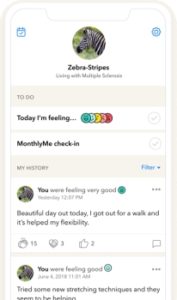
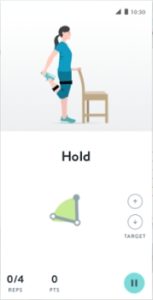
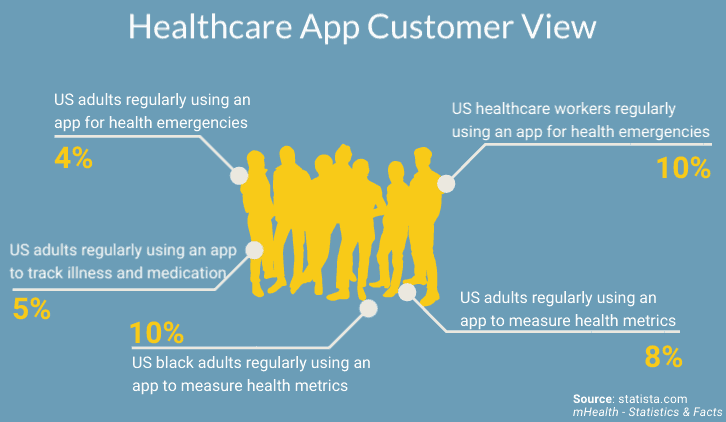
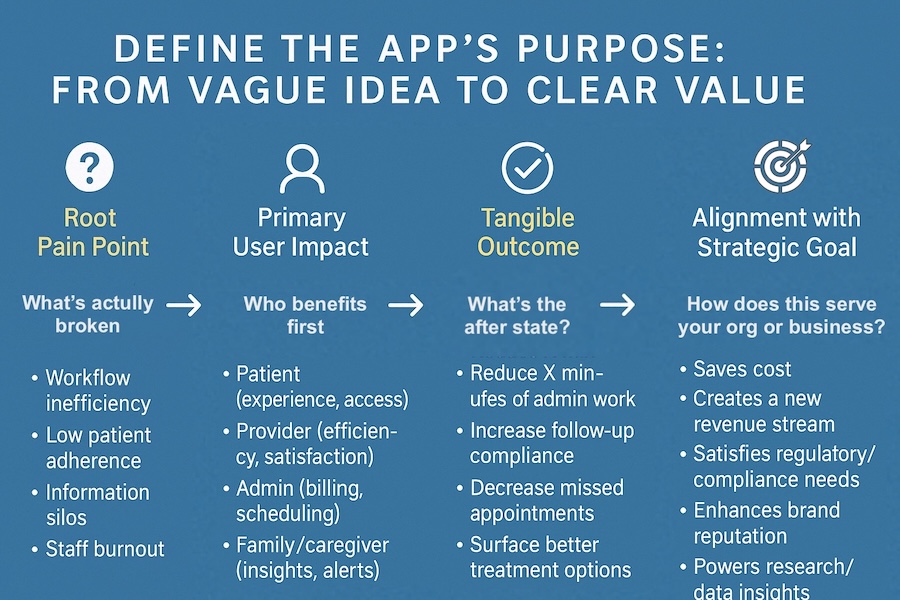
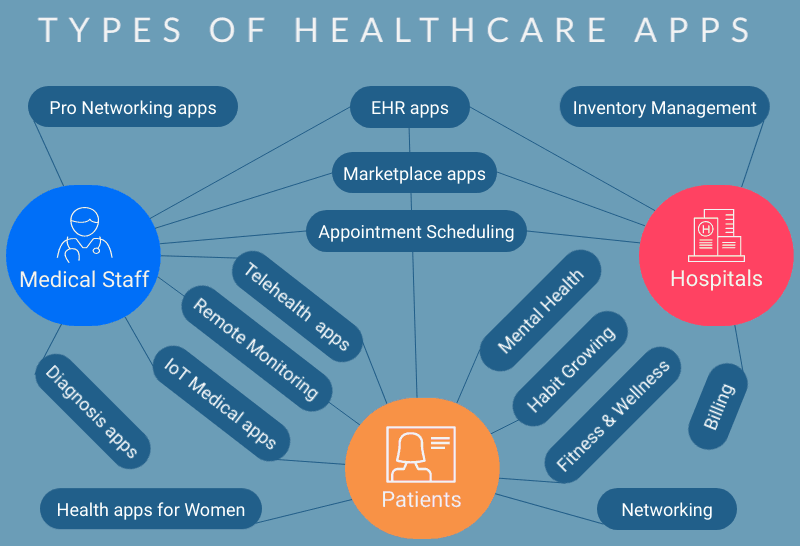
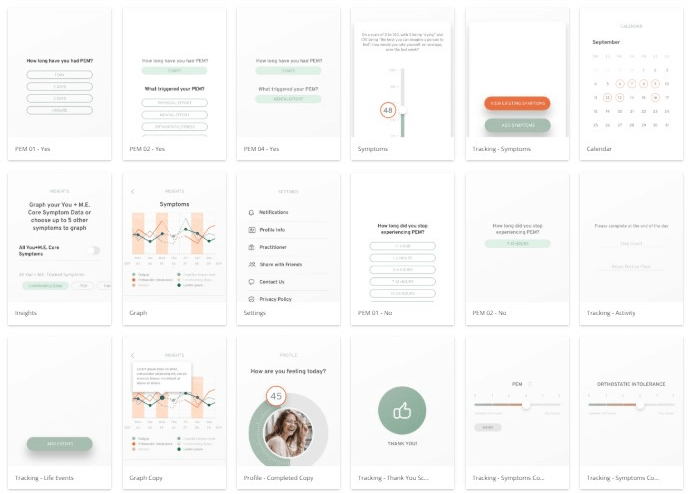
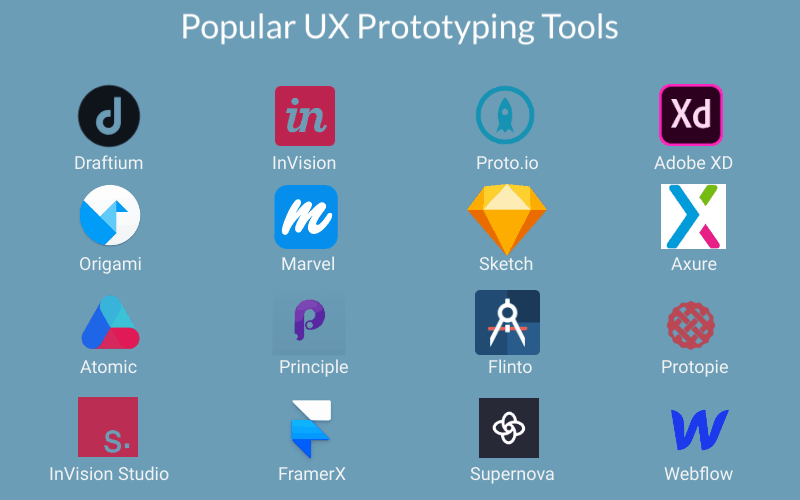
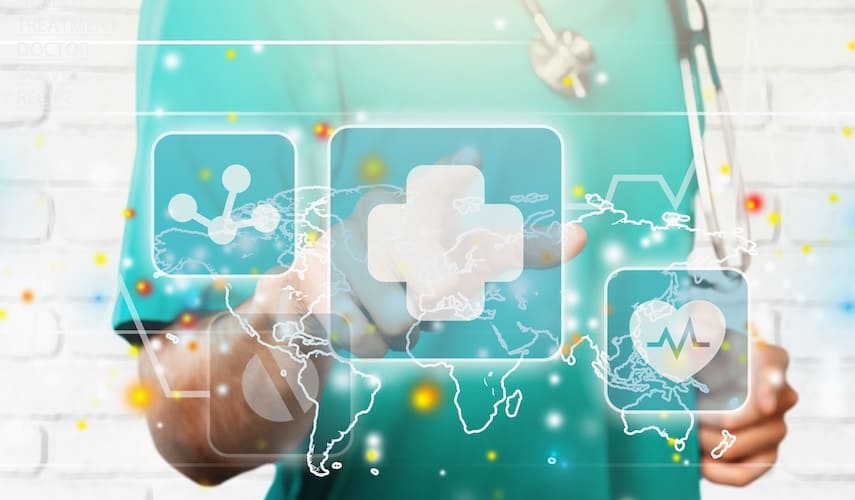
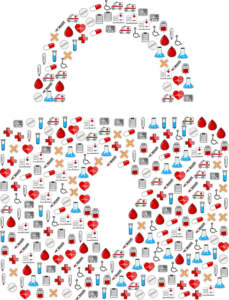 Apple’s Human Interface Guidelines for CareKit and HealthKit
Apple’s Human Interface Guidelines for CareKit and HealthKit